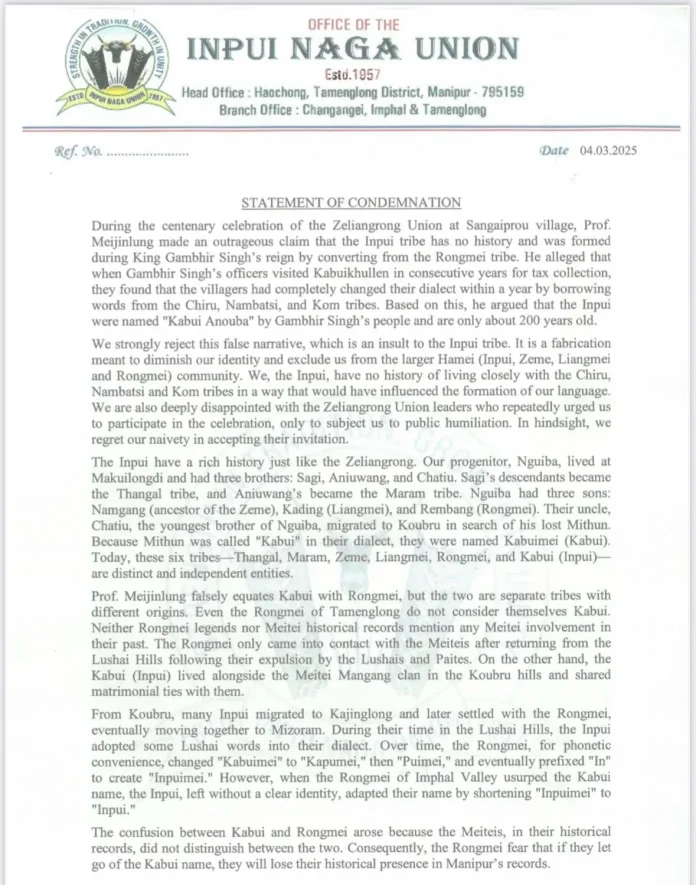SENAPATI, March 5: The Inpui Naga Union has strongly condemned the recent statement made by Prof. Meijinlung during the centenary celebration of the Zeliangrong Union at Sangaiprou village. The professor had claimed that the Inpui tribe has no independent history and was formed during King Gambhir Singh’s reign by converting from the Rongmei tribe. According to his assertion, Gambhir Singh’s officers, while collecting taxes from Kabuikhullen village in consecutive years, noticed that the villagers had completely changed their dialect by adopting words from the Chiru, Nambatsi, and Kom tribes. Based on this, he argued that the Inpui were named “Kabui Anouba” by Gambhir Singh’s people and have a history of only about 200 years.
The Inpui Naga Union has outrightly rejected this claim, calling it a fabricated narrative designed to undermine the identity of the Inpui people and exclude them from the larger Hamei community, which comprises the Inpui, Zeme, Liangmei, and Rongmei tribes. The Union firmly stated that the Inpui have no historical connection with the Chiru, Nambatsi, and Kom tribes in a way that could have influenced their language.
The Union also expressed disappointment with the Zeliangrong Union leaders, who had persistently urged Inpui representatives to attend the centenary celebration, only to subject them to what they described as public humiliation. They regretted their decision to participate in the event.
Inpui’s Rich Historical Legacy:
Defending the historical roots of the Inpui, the Union stated that the tribe traces its lineage to its progenitor, Nguiba, who lived in Makuilongdi. Nguiba had three brothers—Sagi, Aniuwang, and Chatiu. Sagi’s descendants became the Thangal tribe, and Aniuwang’s descendants became the Maram tribe. Nguiba’s three sons—Namgang (ancestor of the Zeme), Kading (Liangmei), and Rembang (Rongmei)—formed distinct tribes, while their uncle, Chatiu, migrated to Koubru in search of his lost Mithun. Since Mithun was called “Kabui” in their dialect, they were later known as Kabuimei (Kabui). Today, the Thangal, Maram, Zeme, Liangmei, Rongmei, and Kabui (Inpui) exist as independent tribes.
The Inpui Naga Union argued that Prof. Meijinlung’s claim that “Kabui” and “Rongmei” are the same is historically incorrect. Even among the Rongmei of Tamenglong, many do not identify as Kabui. Furthermore, neither Rongmei folklore nor Meitei historical records mention Meitei influence on their past. According to the Union, the Rongmei only came into contact with the Meiteis after returning from the Lushai Hills, following their expulsion by the Lushais and Paites.
On the other hand, the Kabui (Inpui) historically lived alongside the Meitei Mangang clan in the Koubru hills and even shared matrimonial ties with them. From Koubru, many Inpui migrated to Kajinglong, later settling with the Rongmei before moving together to Mizoram. During their time in the Lushai Hills, the Inpui adopted some Lushai words into their dialect. Over time, for phonetic convenience, the Rongmei changed “Kabuimei” to “Kapumei,” then “Puimei,” and eventually prefixed “In” to form “Inpuimei.” However, when the Rongmei of Imphal Valley began using the Kabui name, the Inpui—left without a clear identity—shortened “Inpuimei” to “Inpui.”
Misrepresentation in Historical Records:
The Union pointed out that the confusion between Kabui and Rongmei arose because Meitei historical records did not distinguish between the two. Consequently, the Rongmei fear that if they relinquish the Kabui name, they may lose their historical presence in Manipur’s records. Even today, many Meiteis refer to the Inpui, Zeme, Liangmei, and Rongmei collectively as Kabui, perpetuating this historical misunderstanding.
Despite such misrepresentation, the Inpui Naga Union affirmed that the Inpui remain one of the indigenous tribes of Manipur with deep historical roots and strong ties to the Meitei community. The legendary Kabu Salang Maiba, a key figure in the 12th-century Khamba-Thoibi epic, belonged to the Inpui tribe, as confirmed by historians Gangmumei Kamei and Marulung Remmei in their books A History of the Zeliangrong Nagas and Zeliangrongi Wari Singbul. Additionally, Shri Tepipa from Khongakhul (Inkam), an Inpui village, was among the Maichou Tariat who defended Manipur’s religion and culture during the reign of King Garibniwaz (1709-1751).
Rebuttal to Prof. Meijinlung’s Claim:
The Inpui Naga Union questioned how Prof. Meijinlung could claim that the Inpui tribe is only 200 years old when historical figures such as Kabu Salang Maiba and Tepipa had already established the presence of the Inpui people centuries ago. The Union described his statement as a deliberate attempt to distort history and erase the Inpui’s existence.
Rejecting any claims that the Inpui are an offshoot of another tribe, the Union maintained that they have existed as a distinct community for centuries. They strongly opposed any misrepresentation of their identity and demanded that their historical legacy be acknowledged and respected. The Union warned that any further attempts to undermine their existence would be met with strong resistance.

